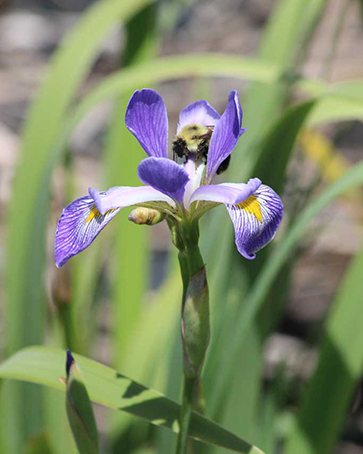Blue Flag Iris
 Iris virginica
Iris virginica
Blue Flag Iris is beautiful swaying in the breeze and an ideal flower for a rain garden, offering beautiful blue-violet blooms with a pleasant fragrance and requiring little maintenance.
Introduction
A true wetland species, it thrives in shallow standing water or extremely damp soil but can also grow in moderately moist conditions. Over time, it spreads slowly from rhizomes, gradually forming a lovely clump. Its seeds float, so when carried by water, they can take root far from the parent plant. If you’re collecting seeds to spread, make sure they stay moist, as they lose their viability if they dry out.
This flower can be found growing along Heron Pond at Gabis Arboretum.
Life Cycle
Perennial
Sun Exposure
Full, Partial
Soil Moisture
Wet, Medium-Wet, Medium
Height
3 feet
Bloom Time
May, June, July
Bloom Color
Purple
About the Plant
The flowers are cross-pollinated primarily by bumblebees and long-horned bees, with occasional visits from butterflies and skippers. This plant is toxic to mammals, so it’s unlikely to be bothered by deer or rabbits. These insects primarily collect nectar, though some bees also gather pollen. Various insects feed on Blue Flag Iris, including the weevil Mononychus vulpeculus (whose larvae feed inside the seed capsules), the fly Cerodontha magnicornis (larvae mine the leaves), and the Syrphid fly Eumerus tuberculatus (larvae feed on rhizomes). Other insects that feed destructively include the mealybug (Rhizoecus falcifer), aphid (Dysaphis tulipae), and thrips (Frankliniella occidentalis). Caterpillars of moths like the Virginia Ctenucha, Agreeable Tiger Moth, and Iris Borer Moth also feed on the plant.